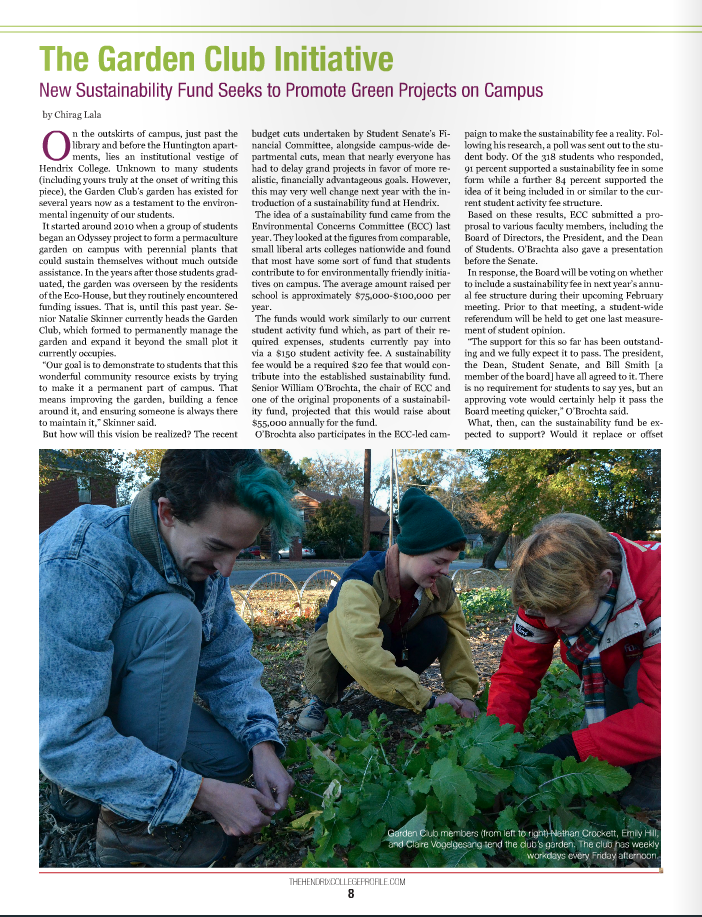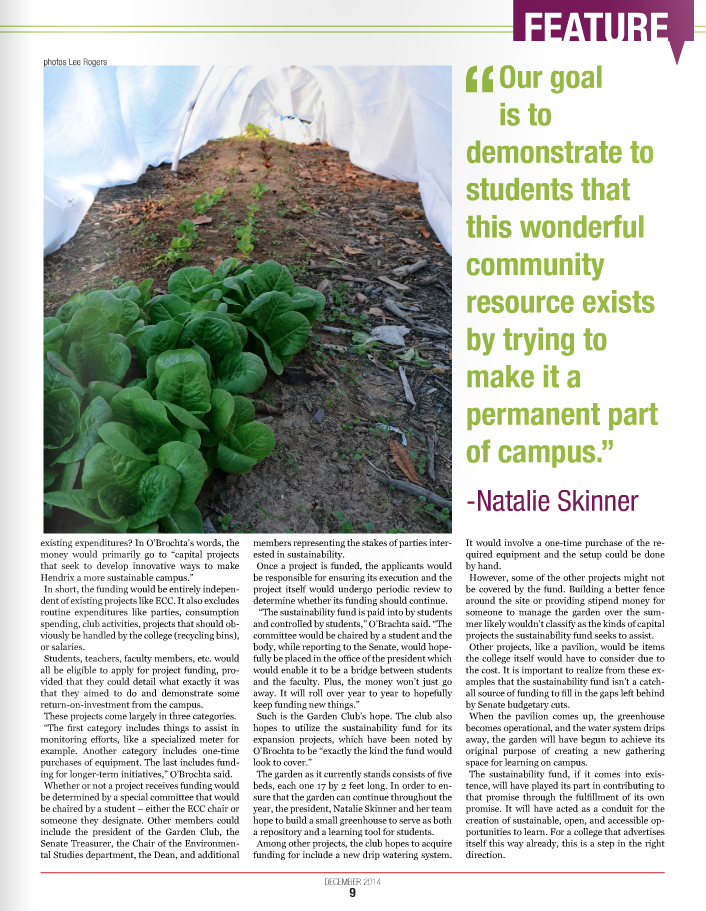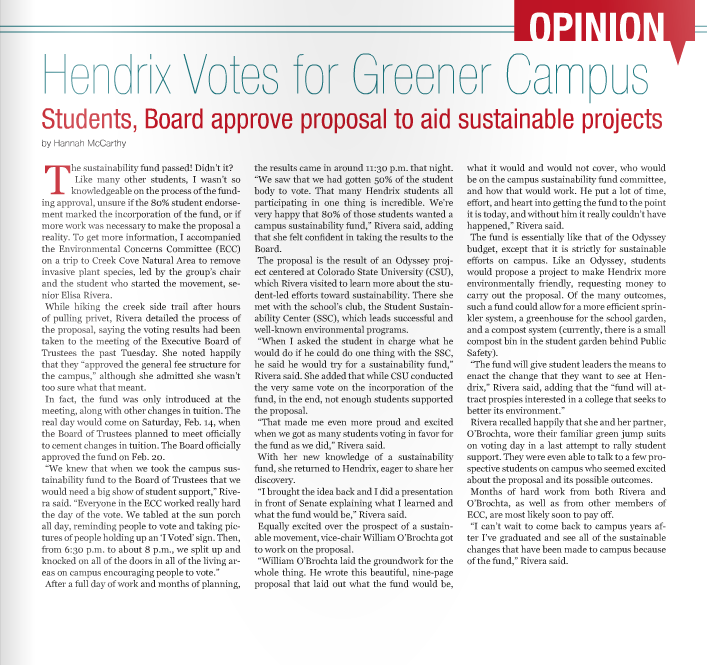The Hendrix College Campus Sustainability Fund Committee
project was the brainchild of Elisa Rivera ’15 and William O’Brochta ’16. The proposal
began in 2014 with Elisa Rivera completing a Special Projects Odyssey Project
at Colorado State University during Spring Break. During this Odyssey Project,
Elisa learned that the biggest improvement to sustainability that Colorado
State University recommended was establishing a Campus Sustainability Fund. On
April 8th, Elisa gave a presentation about her findings to Student
Senate. That month, William O’Brochta began researching existing Campus
Sustainability Funds throughout the country. The formal CSFC proposal took
shape throughout the summer.
Upon returning to Hendrix in the fall of 2014, an
initial proposal was presented to the Environmental Concerns Committee and
Student Senate in September during which time a survey of all students on
campus was conducted with 318 respondents indicating 92% support for the
establishment of a Fund and an average willingness to pay of $20 per student
per semester. The proposal benefited from a three article series about
sustainability issues in The Profile
as well the endorsement of Student Senate, the Office of the President, the
Dean of Students, the Young Democrats and College Republicans, the
Environmental Concerns Committee, and members of the Board of Trustees. It was
decided that the student body should vote on a referendum to adopt the CSFC and
its associated fee in the spring of 2015. This vote was conducted on January 28th
with half the student body participating and 80% voting in favor of the
referendum. This was the first student referendum vote in the history of
Hendrix, the highest voter turnout in memory for an online Hendrix election,
and a decisive victory for the Fund. On February 3rd, the Executive
Committee of the Hendrix Board of Trustees met and approved the general fee
structure for the 2015-2016 academic year including the Campus Sustainability
Fund Fee. The entire Board of Trustees voted in favor of the CSFC during their
February 12th meeting, and the Fund took effect in the fall of 2015.
Designing the CSFC Logo
The CSFC Logo contains an emblem meant to denote the mission and vision of the CSFC. A hand is clasped around a leaf. This design signifies the relationship between humans and the environment and the trust the natural world has placed in humans to help take care of it.
Initial Press Coverage
The Hendrix College Profile-April 2014

The Hendrix College Profile-December 2014


The Hendrix College Profile-March 2015

CONWAY LOG CABIN DEMOCRAT-February 20, 2015
"Hendrix Campus Sustainability Fund Approved"
Hendrix students and the Board of Trustees have approved a Campus Sustainability Fund to support sustainability projects on campus.
The proposal, led by the Environmental Concerns Committee, was approved by 80 percent of the 600 students who voted on the initiative. The fund was formally approved today by the Hendrix College Board of Trustees at the February board meeting.
The fund will be created by a dedicated $20 student fee per semester. Money from the fund will be allocated, on a competitive basis, to large sustainability projects designed by students, faculty and staff.
ECC Chair Elisa Rivera ’15 visited with Colorado State University sustainability coordinators and program managers who said a sustainability fund was the best method for sustainability on the right track. William O’Brochta ’16 joined a listserv of sustainability managers across the country to research sustainability funds and how they can be implemented.
“We both felt that getting money for sustainable projects was the best way to start addressing the problem if that money could be distributed by students to student-, faculty- and staff-designed projects,” said O’Brochta, who researched and developed the proposal during the summer. “From all my experience working with Facilities, I know they have tons of projects ready to implement that are sustainability related but can never get the funding.”
By creating a new fund, rather than re-allocating money from the general budget, students get to decide where the money goes, O’Brochta said.
“Being student led, students, faculty, and staff only benefit from what they want to happen, they know where their money is going, and they help keep the fund accountable,” he said. “It’s a great way to develop an open and transparent system.”
ECC presented the idea of the fund at a Student Senate meeting and then conducted a survey to determine student interest in creating a fund and to determine the amount of money that students were willing to pay. ECC presented the proposal and invited input at several Student Senate meetings, during a meeting about the fund with Hendrix President Bill Tsutsui, at a panel event co-sponsored by the Young Democrats and College Republicans, at several special ECC meetings, by speaking directly to several members of the Board of Trustees, and in meetings with the Dean of Students.
“We tried as hard as possible to make sure that everyone who wanted to have input into the proposal was able to do so in as many different opportunities as possible,” O’Brochta said. “We spent all of last semester working toward this goal.”
“Passage of the fund is something for the student body to celebrate having achieved,” he said. “This was a true grassroots movement that could not have happened without the support and hard work of students.”
O’Brochta sees the fund as a catalyst to bring more sustainable projects to campus, perhaps including a sustainability coordinator and increased sustainability education.
“A dedicated sustainability coordinator is something that is even more popular on college campuses than a sustainability fund. The sustainability coordinator would be able to focus full-time on the issues that many different people are currently working on in their spare time.
This would mean a holistic approach to sustainability and would provide the best mechanism for developing projects for the fund to award money to,” he said. “Additionally, the fund hopefully pushes students toward learning more about sustainability and environmental issues because of the research required to develop and implement a sustainability project like the kind we would fund.
There is a massive trend in colleges toward sustainability education and making sure that all students have some environmental literacy when they graduate from college.
The fund would be a catalyst for such a push to occur on the Hendrix campus. So, I characterize the fund as a huge first step.”
The Campus Sustainability Fund Committee will begin developing this summer. Students, faculty and staff are encouraged to submit project ideas at HendrixECC.tk or prepare funding proposals for projects to send the Committee when it begins its work this fall.
CONWAY LOG CABIN DEMOCRAT-March 9, 2015
"Campus Sustainability Led By Student-Generated Projects"
By Jeanette Anderton
LOG CABIN STAFF WRITER
Project ideas for the Campus Sustainability Fund Committee at Hendrix College have flooded in following the board of trustees’ approval of a student fee to fund the initiative last month.
William O’Brochta, who helped drive the proposal and will chair the committee next semester, said the committee has received 20-30 project ideas that consist of making improvements to existing structures.
“The most popular suggestion so far is improving the sprinkler system to sprinklers that don’t come on when it’s pouring down rain and that don’t water the sidewalks,” he said.
Another common suggestion was providing a greenhouse for the Garden Club, he said.
The projects will be funded by a $20 student fee that will be added to tuition in the 2015-16 school year and will be chosen by the committee, which comprises six faculty/staff members and five students.
“This is a student initiative,” O’Brochta said. “That’s why we have so many students on the committee. When they come to us with a project idea, they will get not only funding, but advice and support right off the bat.”
Another project the committee is considering could have lasting effects. The project would baseline energy improvements in half the apartments in a complex and monitor how much money was saved compared to the unimproved apartments.
“If it’s significant enough, the committee would budget to improve all the apartments on campus,” O’Brochta said.
Elisa Rivera, who co-founded the iniative with O’Brochta, said she was honored to help set up such an important, student-led committee.
“Getting people the funding they need for exicting projects that will last is such a benefit,” she said.
Students and faculty can submit project ideas at HendrixECC.tk.